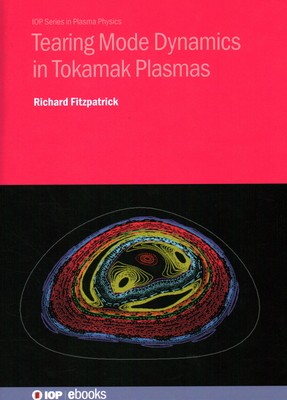
- We will send in 10–14 business days.
- Author: Richard Fitzpatrick
- Publisher: IOP Publishing Ltd
- ISBN-10: 0750353651
- ISBN-13: 9780750353656
- Format: 17.8 x 25.4 x 2.1 cm, kieti viršeliai
- Language: English
- SAVE -10% with code: EXTRA
Reviews
Description
The development of humankind's ultimate energy source, nuclear fusion, has proceeded slowly but surely over the course of the last 60 years. This comprehensive book aims to outline a realistic, comprehensive, self-consistent, analytic theory of tearing mode dynamics in tokamak plasmas. It discusses a fluid theory of a highly magnetized plasma that treats the electrons and ions as independent fluids, and then proceeds to develop the theory of tearing modes, first approximating the geometry of a tokamak plasma as a periodic cylinder, but eventually considering the toroidal structure of real tokamak plasmas. This book also describes the stability of tearing modes, the saturation of such modes, and the evolution of their phase velocity due to interaction with other tearing modes, as well as the resistive vacuum vessel, and imperfections in the tokamak's magnetic field. This text would appeal to scientists and graduate students engaged in nuclear fusion research, and would make a useful reference for graduate plasma physics courses.
Key Features
- Develops a systematic theoretical framework for the investigation of tearing mode dynamics in tokamak plasmas
- Starts with the simple cylindrical linear approach and gradually introduces more realistic features such as nonlinear effects, neoclassical effects, and toroidal effects
- Includes systematic exploration of error-field penetration in tokamak plasmas
- Includes systematic exploration of the rotation and locking of tearing modes due to their interactions with resistive walls and error-fields
EXTRA 10 % discount with code: EXTRA
The promotion ends in 22d.09:44:53
The discount code is valid when purchasing from 10 €. Discounts do not stack.
- Author: Richard Fitzpatrick
- Publisher: IOP Publishing Ltd
- ISBN-10: 0750353651
- ISBN-13: 9780750353656
- Format: 17.8 x 25.4 x 2.1 cm, kieti viršeliai
- Language: English English
The development of humankind's ultimate energy source, nuclear fusion, has proceeded slowly but surely over the course of the last 60 years. This comprehensive book aims to outline a realistic, comprehensive, self-consistent, analytic theory of tearing mode dynamics in tokamak plasmas. It discusses a fluid theory of a highly magnetized plasma that treats the electrons and ions as independent fluids, and then proceeds to develop the theory of tearing modes, first approximating the geometry of a tokamak plasma as a periodic cylinder, but eventually considering the toroidal structure of real tokamak plasmas. This book also describes the stability of tearing modes, the saturation of such modes, and the evolution of their phase velocity due to interaction with other tearing modes, as well as the resistive vacuum vessel, and imperfections in the tokamak's magnetic field. This text would appeal to scientists and graduate students engaged in nuclear fusion research, and would make a useful reference for graduate plasma physics courses.
Key Features
- Develops a systematic theoretical framework for the investigation of tearing mode dynamics in tokamak plasmas
- Starts with the simple cylindrical linear approach and gradually introduces more realistic features such as nonlinear effects, neoclassical effects, and toroidal effects
- Includes systematic exploration of error-field penetration in tokamak plasmas
- Includes systematic exploration of the rotation and locking of tearing modes due to their interactions with resistive walls and error-fields


Reviews